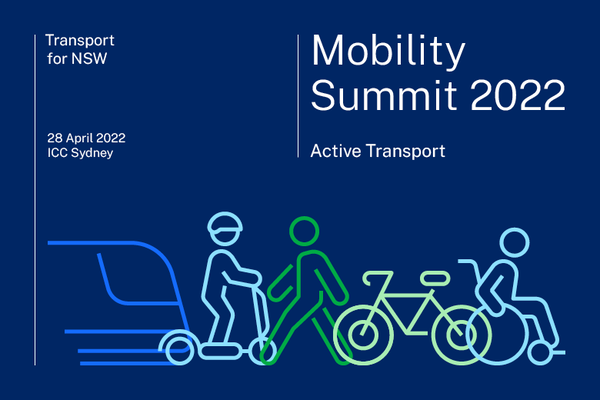
Active Transport Mobility Summit 2022
Transport for NSW's Active Transport Mobility Summit sets the direction for Active Transport investment in NSW.
The 2022 summit was held at the International Convention Centre Sydney on Thursday 28 April 2022.
It brought together more than 100 government practitioners, researchers and industry experts.
Participants shared ideas on infrastructure, culture and regulations that will shape our state’s future that could encourage walking and cycling in NSW.
Image
Image controls:
Strategic Cycleway Corridors - Eastern Harbour City Overview
As part of the Mobility Summit, Active Transport Minister Rob Stokes announced the Strategic Cycleway Corridors for Eastern Harbour City.
View the Program Update (PDF, 1.06 MB).
The program sets out the strategic cycleway network for the Eastern Harbour City and will identify how each corridor should be prioritised.
Communities will be consulted as each corridor is developed ensuring local needs and outcomes are considered.
E-scooter trial
Transport for NSW will bring forward a shared e-scooter trial to July. The trial will focus on ensuring shared e-scooter regulations are sensible, safe and appropriate for NSW.
Interested councils can still submit an expression of interest to take part. Regulations will be made public in coming weeks.
Mobility Summit panel discussions and breakout sessions
Panel session 1 discussed e-scooter trials. The participants looked at learnings from other states and how NSW can move forward.
Chair: Peter Achterstraat (Chair)
Panel: QLD: Daniel O Kaden VIC: Karen Roache E-scooter provider leads from Neuron, Beam and Lime
Download Peter Achterstraat's presentation (PDF, 3.47 MB). Watch the session in the video below:
Image
Image controls:
In panel session 2 experts discussed what NSW should stop, start and change to create great walkable places and encourage more people to walk or cycle.
Gabriel Metcalf (Chair)
Panel: Margy Osmond, Fiona Campbell, Paul Nicolaou, Lena Huda
Watch the session in the video below:
Image
Image controls:
Mobility Summit 2022 guest speakers
Keynote speakers
Dr Will Norman, Walking and Cycling Commissioner, London City Hall
Will Norman became London’s first Walking and Cycling Commissioner in 2016. Under his leadership, London has added almost 250km of cycling routes. Thousands of Londoners now choose greener, cleaner and healthier ways of traveling around the city.
Will told the Summit how NSW can build the case for change and create great places for all.
View Will Norman's presentation.
Image
Image controls:
Henriette Vamberg
Henriette leads the work focused on city transformations at Gehl. Since starting at Gehl in 2000 she has worked with a number of public and private clients and has led many of the major projects that have been developed at Gehl. This work has brought her to different destinations in Europe, the USA, Russia, India, Australia and New Zealand.
Henriette discussed Copenhagen’s transformation into a bike nirvana and offered some lessons for NSW.
Download the presentation (PDF, 15.55 MB).
Carol Schweiger
Carol Schweiger, Chairperson of New England Intelligent Transportation Society and President of Schweiger Consulting, has 38 years of experience, and is nationally and internationally recognised in transportation technology consulting.
Her wide-ranging and in-depth expertise is in several speciality areas including technology strategies for public agencies, public transit technology, traveller information strategies and systems, and systems engineering.
Carol reminded us that access to suitable, affordable transport is an equity issue.
Download the presentation (PDF, 1.94 MB).
Download the Mobility Summit program guide (PDF, 71.82 KB).
Connect with us on social
Mobility summit guests shared their feedback on social media using the hashtag #MobiltySummit22 and tagging @TransportforNSW
Look out for information on our social media channels:
More information
Transport for NSW is focused on investment and reform for Active Transport. Find out what we have already done to encourage active transport through improved infrastructure, better facilities and safer environments for cyclists and pedestrians:
